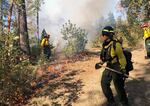Nearly $3 million is being invested into projects intended to lessen wildfire risk across Oregon.
The Oregon State Fire Marshal’s office says $2.7 million are going towards what’s called community wildfire protection plans (CWPP.) There are over two dozen ready-to-go in 25 counties. They include fuel mitigation programs, defensible space projects, and home assessments.
Alison Green, the public affairs director for the OSFM, said this is a new initiative.
“Our office was very fortunate in 2021, the last biennium to actually get an investment to reduce risk to communities,” Green told KLCC. “For us to really have this money to lessen the risk, and protect people, this was such an amazing opportunity.”
The funds are part of the OSFM’s Fire Adapted Oregon initiative, created by Senate Bill 762.

A fire boss and trainees carry out a controlled burn outside of Eugene in Oct. 2021. These limited and contained burns are to deprive fuel for larger fires, and rejuvenate certain habitat.
Brian Bull/KLCC
Oregon had its worst wildfire season in 2020, with over a million acres burned.
Meanwhile, Green said the wildfire outlook for 2023 looks more typical than some of the more severe seasons in recent years.
She added while it’s still early, analysts are already evaluating some factors that could determine the severity of the wildfire season.
“One of them is snowpack, and also what kind of rain we get and how long it lasts,” explained Green, adding that they also review drought monitor readings.
“But as far as how it’s going to start and when it’s going to start, we’re hoping that it’s a more traditional fire season, a little bit later into the summer, versus some of the ones that we’ve seen in the past that were starting in May.”
Global warming has caused hotter, drier conditions across the region, making forests more susceptible to wildfires.
Humans, not nature, remain the top culprit.
©2023, KLCC.



